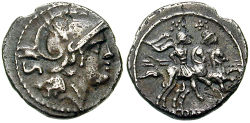 |
| Sesterius. The standard Roman accounting SP at 10 SP to 1 GP |
2. The sums paid by those who kept their cattle on the public pastures. The amount was not recorded, but was apparently lucaive, so charge the higher rate - one fifth of the increase in any herd pastured on public land.
3. The harbour duties raised upon imported and exported commodities. One twentieth the value of the goods, including slaves.
4. The revenue derived from the salt-works. One denarius (a large silver piece worth four regular silver pieces (sesterius)) per 60 pecks (524 liters)
5. The revenues derived from the mines (metalla).
This branch of the public revenue cannot have been very productive
until the Romans had become the masters of foreign countries. Until that
time the mines of Italy appear to have been worked, but this was
forbidden by the senate after the conquest of foreign lands (Plin. H. N.
XXXIII.4,º
XXXVII.13). The mines of conquered countries were treated like the salinae, that is, they were partly left to individuals, companies, or towns on condition of a certain rent being paid (Plin. H. N. XXXIV.1; Cic. Philip. II.19), or they were worked for the direct account of the state, or were farmed by the publicani. In the last case, however, it appears always to have been fixed by the lex censoria how many labourers or slaves the publicani should be allowed to employ in a particular mine, as otherwise they would have been able to derive the most enormous profits
(Plin. H. N. XXXIII.4). Among the most productive mines belonging to the republic we may mention the rich gold-mines near Aquileia
(Polyb. XXXIV.10), the gold-mines of Ictimuli near Vercelli, in which 25,000 men were constantly employed (Plin. H. N. XXXIII.4;º
Strab. V. p151), and lastly the
silver-mines in Spain in the neighbourhood of Carthago Nova, which
yielded every day 25,000 drachmas to the Roman
aerarium
(Polyb. XXXIV.9; cf. Liv. XXXIV.21).
Macedonia, Thrace, Illyricum, Africa, Sardinia, and other places also
contained very productive mines, from which Rome derived considerable
income.
6. The hundredth part of the value of all things which were sold (centesima rerum venalium). This tax was not instituted at Rome until the time of the civil wars; the persons who collected it were called coactores
For slaves it was charged at two percent.
7. The vicesima hereditatium et manumissionum. Freeing a slave costs the owner one twentieth of the slaves value as a tax. A nice one to charge your paladins for doing good deeds.
9. A tax upon bachelors. Not contributing to the future of the state? Five percent every census, for unmarried men, excluding widowers, over the age of twenty five.
10. A door-tax and a pillar tax. These are taxes on palaces or fancy townhouses, two percent for every door, and one percent for each external pillar. [Ed. Value is calculated based on the total cost of the building.]
11.
The octavae. In the time of Caesar all liberti living in Italy and possessing property of 200 sestertia, and above it, had to pay a tax consisting of the eighth part of their property. The liberti were freed men (former slaves) , but this works as a tax on any novaeu riche, such as successful adventurers.
See Vectigalia for the source of the information.

#9: 5% of what, total personal worth?
ReplyDelete#10: 2%, 1% of what, value of the building?
Excellent questions Tom. Romans always based their taxes on total property owned. So #9 would be based on all the property the individual owns and would have been due once per census, or about every five years.
DeleteFor #10, yes, it would be based on the total value of the building. This is basically what we would call a "sin tax", such as we charge on alcohol and cigarettes. The primary purpose is to promote correct behavior, the revenue is a secondary consideration to the state.